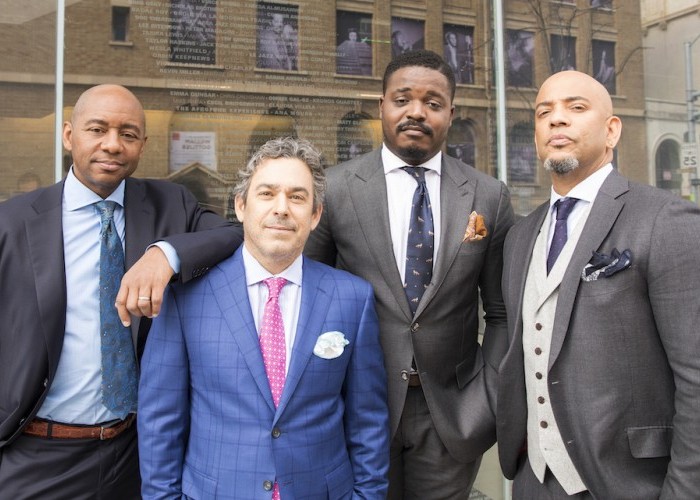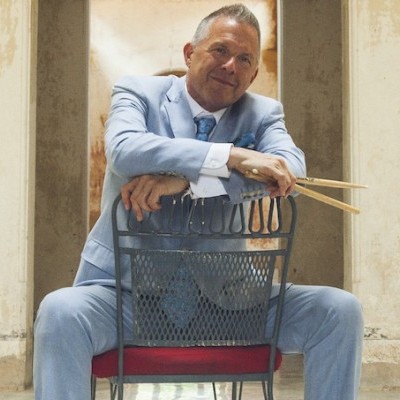Oct 28, 2025 10:47 AM
In Memoriam: Jack DeJohnette, 1942–2025
Jack DeJohnette, a bold and resourceful drummer and NEA Jazz Master who forged a unique vocabulary on the kit over his…

The Braford Marsalis Quartet’s latest album, The Secret Between The Shadow And The Soul, features compositions by the bandleader, pianist Joey Calderazzo and bassist Eric Revis. Drummer Justin Faulkner rounds out the ensemble.
(Photo: Scott Chernis)Is your team the jazz lineage—the musical tradition that will carry on after you’re gone?
Despite all of the prognostications to the contrary, yes, it shall carry on. But I’m not working for that team. I love jazz. I love music. And I’ve learned how to play all styles of music. I don’t take a one-sound-fits-all approach, learn five unique licks that are mine and impose them on everything. I avoid that way of thinking. We get caught up in all this useless crap. The word “innovation” in jazz is a joke. None of this shit is innovative. The only thing that can be innovative in music, anyway, is sound.
Wynton said something once in a discussion that knocked me out, talking about innovation in jazz. Jazz didn’t invent harmony: All the harmony jazz guys use has been used in one iteration or another in classical music in the last 100 years. True. The two things that jazz contributed to the world were consistent use of the flatted third and the flatted seventh in the melodic context and the swing beat. That’s it. Now, you think about modern music, and they employ neither technique. So, they bandy this word “innovation” around, and the innovation is based on structure. It’s all been done! So, then to make it unique, a lot of modern music is ostinato bass lines on odd meters.
And songs are no longer called songs; they’re called vehicles for improvisation—as though improvisation is the provenance of jazz. Every culture has improvised over the last 5,000 years. You can hear improvisation in klezmer music, in Balinese music, Indian music, in bluegrass music, in the blues. And the irony is that most of the people who are called improvisers aren’t really improvisers. They’re just regurgitating. And at the same time, with a straight face, they say, “I wonder why no one likes jazz anymore.” [laughs]
Could you talk about the new way you’ve pulled from classical, New Orleans and jazz and put it together in new way?
Think about it this way: If the goal of playing jazz is to be new, and new means you’re playing things that no one’s ever heard before, then if you were really interested in being new, it’d be in your benefit to learn no jazz at all. Because then anything you play will sound new because it is disconnected from any semblance to tradition. ... I just want to be good. I want to be in a musical situation where, if our band fell into a time machine, people would say, “I don’t know what that shit is, but they’re really good at it.” The goal is good; I don’t really care about new. Sometimes that stuff winds up being new, but that’s to be decided later.
Think about [how] John Coltrane plays “Impressions,” and you read all these reviews where they’re saying, “This is new, this is new, this is new,” when the whole piece was composed chapter-and-verse by a guy named Morton Gould in 1939. I don’t know any good music that isn’t borrowed from somewhere else. It has nothing to do with where the data comes from; it’s about how the data sounds. And, yes, he took “Impressions” from American Symphonette No. 2: “Pavane.” It sure don’t sound like American Symphonette No. 2: “Pavanne” when he plays it. And that’s all that really matters. So, I’ve been stealing since I joined Blakey’s band and understood the interconnectivity of all these guys when they start talking about who they listen to, and how they grew up, and what their influences were.
You’ve been playing the songs on the new album for a couple of years live; how did you winnow it down to the seven on the album?
Those are the songs I like. Those are the songs the guys in the band like.
Was “The Windup” something you’d been doing in the set?
We played it two years ago. And then we started playing with Kurt [Elling], so we switched into that gear. I’d been wanting to play the song for years. I went through a lazy period where I was listening and practicing a lot of saxophone, but what I hadn’t done in a long time was sit down with a set of headphones and listen to a song and just write the song out. I’m not a fan of fakebooks, except in emergency situations, because every time I commit to writing a song down, that makes me better. It doesn’t make me better to download it. I wrote down “The Windup” chart and said, “Here you go, let’s do this tonight.” And they all said yea! Because we all know the record. We’ve heard the record a million times.
When you teach, can students keep up with your ideas about sound, listening and learning?
No. Because they’re not old like us. They’re 19. Most of my students come in with a completely separate idea of what jazz actually is.
And what is that?
That it’s learning how to play certain kind of repetitive licks and patterns over chord structure.
I say two things to the students: “Why are you here?” They don’t have an answer. Then, “Play a C scale two octaves up and down.” They play it. [I ask,] “What does that sound like?” They have no idea. So, we’ve established, in less than a minute, you have no idea why you’re here and you have no idea what you sound like. The lesson’s pretty much over. “When you figure out one of those, come back and we can start.” Some of them tell me, “Go screw yourself,” and they don’t come back. Which is a win for me. The majority of them come back, and from that point forward, we’re about to have real lessons about what it means to play music. People want to go to school and hear they’re good. They should want to go and hear they suck. They don’t go for information; they go for affirmation.
You mentioned posting scientific and other articles on Twitter. Do you find that reading about a variety of subjects helps to rest or work your brain differently than music does?
I don’t know. Most musicians I know tend not to be that way. When you go to music sites, they just post about music. It’s not for me. There’s a one-dimensionality to it that’s not to my liking. My dad and I didn’t agree on that, but I’ve always had that kind of holistic thinking. We were forced to live in multiple worlds. We were living in a predominantly black neighborhood at that time and I was going to predominantly white schools. So, especially growing up post-segregation, which meant it was still there although not in law but in mindset, you had to negotiate these worlds. One of the things my dad said that was really helpful: “You don’t allow other people to define you. Because if you don’t believe what they say, then what they say really doesn’t matter.” That really helped me when I moved to New York.
People were joining all these music camps, people saying what is and isn’t possible, what’s good and not good based on absolutely nothing other than their personal opinion. I started listening to music for hours and hours and hours. And I started hearing things in music that I didn’t hear before. And then you say something like, “It’s really interesting when you listen to the [1967] Miles Davis record Sorcerer. On the first song, “Prince Of Darkness,” Miles gets lost in the middle of the solo and he’s a half beat off about the entire second half of the solo.” And everyone says, “Man, that’s bullshit.” No, it’s not, really. I heard it. You can hear the band bring him back to where the beat is; you can hear Tony Williams banging out the tempo. And in the end, they just go where Miles goes. Because he is Miles. As you get older, you realize, Miles was an old man, born in the ’20s, grew up listening to Louis Armstrong, trying to stay modern. It’s not like he could hear all that stuff they were playing. What he did was masterful. Wayne Shorter starts creating all these complex structures, Miles can’t hear the structures, so he just tells Herbie to stroll. Herbie doesn’t play the chords, so anything Miles plays sounds right. And what he mostly plays are a couple of chromatic scales and a couple of phrases and things he’d done in his prior musical lifetime. And I’ve been there, and I use that technique sometimes [laughs].

Jack DeJohnette boasted a musical resume that was as long as it was fearsome.
Oct 28, 2025 10:47 AM
Jack DeJohnette, a bold and resourceful drummer and NEA Jazz Master who forged a unique vocabulary on the kit over his…

Always a sharp dresser, Farnsworth wears a pocket square given to him by trumpeter Art Farmer. “You need to look good if you want to hang around me,” Farmer told him.
Sep 23, 2025 11:12 AM
When he was 12 years old, the hard-swinging veteran drummer Joe Farnsworth had a fateful encounter with his idol Max…

D’Angelo achieved commercial and critical success experimenting with a fusion of jazz, funk, soul, R&B and hip-hop.
Oct 14, 2025 1:47 PM
D’Angelo, a Grammy-winning R&B and neo-soul singer, guitarist and pianist who exerted a profound influence on 21st…

Kandace Springs channeled Shirley Horn’s deliberate phrasing and sublime self-accompaniment during her set at this year’s Pittsburgh International Jazz Festival.
Sep 30, 2025 12:28 PM
Janis Burley, the Pittsburgh International Jazz Festival’s founder and artistic director, did not, as might be…

Jim McNeely’s singular body of work had a profound and lasting influence on many of today’s top jazz composers in the U.S. and in Europe.
Oct 7, 2025 3:40 PM
Pianist Jim McNeely, one of the most distinguished large ensemble jazz composers of his generation, died Sept. 26 at…